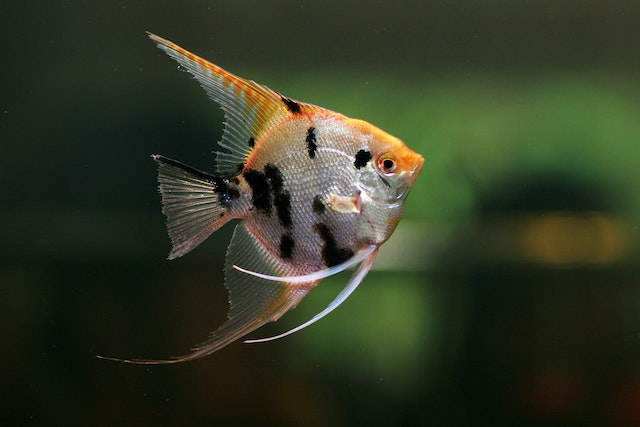There are several reasons why an angel fish may start doing backflips. One possible cause is a swim bladder disorder, which affects the fish’s ability to control its buoyancy.
This can be caused by overfeeding, poor water quality, or a bacterial infection. Another possible cause is stress, caused by overcrowding, aggressive tank mates, or sudden changes in water temperature or pH levels.
If you notice your angel fish doing backflips, it is essential to take action to address the issue. This may involve adjusting the water quality, reducing the fish’s stress levels, or seeking veterinary care if necessary.
By identifying and addressing the underlying cause of this behavior, you can help ensure the health and well-being of your angel fish.
Possible Causes
Water Quality Issues
One possible cause of an angel fish doing backflips is water quality issues. If the water in the tank is not maintained correctly, it can build up harmful chemicals, such as ammonia and nitrite, which can cause stress and illness in fish.
It is essential to regularly test the water and perform water changes as needed to maintain a healthy environment for the fish.
Disease or Infection
Another possible cause of an angel fish doing backflips is disease or infection. Fish can be susceptible to various diseases and conditions, such as swim bladder disease, which can cause them to lose their balance and swim abnormally.
Observe the fish for other symptoms, such as loss of appetite, lethargy, or discoloration, and seek veterinary care if necessary.
Stress or Aggression
Stress or aggression can also be a possible cause of an angel fish doing backflips. If the fish is in a tank with other aggressive or territorial fish, it can lead to stress and anxiety in the affected fish.
It is essential to ensure the fish have enough space and hiding places in the tank to reduce stress and aggression.
In conclusion, several possible causes of an angel fish doing backflips include water quality issues, disease or infection, and stress or aggression.
Observing the fish for other symptoms and seeking veterinary care if necessary to ensure their health and well-being is essential.
Symptoms to Look For
Backflips or Somersaults
If you notice your angel fish doing backflips or somersaults, this could indicate a serious health problem.
This abnormal behavior could indicate a neurological issue or a swim bladder disorder. Swim bladder disorder is a common problem in fish that affects their ability to regulate their buoyancy.
This can cause them to float to the top or sink to the bottom of the tank.
Erratic Swimming Behavior
Another symptom to look for is erratic swimming behavior. If your angel fish is swimming erratically, darting around the tank, or bumping into objects, this could be a sign of a health issue.
This behavior could also indicate stress or poor water quality in the tank.
Loss of Appetite
A loss of appetite is another symptom to look for in your angel fish. If your fish is not eating or is eating very little, this could be a sign of a health issue.
Various factors, including stress, poor water quality, or disease, could cause a loss of appetite.
Monitoring your fish closely and looking for any of these symptoms is essential. If you notice any of these symptoms, it is vital to take action immediately to prevent further health problems.
Treatment Options
Water Changes and Filtration
When an angel fish is doing backflips, one of the first things to do is perform a water change. This helps to remove any toxins or pollutants that may be causing the fish to behave abnormally.
The water change should be followed by regular filtration to maintain the water quality. A good filtration system will help to keep the water clean and healthy for the fish.
Medication or Antibiotics
Medication or antibiotics may be necessary if the water change and filtration do not help. Using the proper medication or antibiotics for the specific condition is essential.
Some medications may harm the fish, so it is essential to consult a veterinarian or a fish expert before administering any medication.
Isolation or Separation
If the angel fish is doing backflips due to aggression from other fish, it may be necessary to isolate or separate the fish. This can be done by placing the fish in a separate tank or using a divider in the existing tank. This will allow the fish to recover and prevent further aggression from other fish.
Overall, it is crucial to identify the root cause of the problem before administering any treatment. Maintaining a healthy and clean environment for the fish is also essential to prevent future health issues.
Preventative Measures
Regular Water Testing and Maintenance
Regular water testing and maintenance are essential for the health and well-being of your angel fish. Maintaining a clean and healthy environment is crucial to prevent diseases and other health problems that can cause your fish to do backflips.
To keep your aquarium clean, perform regular water changes, and use a reliable water testing kit to monitor the water quality. Monitor the pH, ammonia, nitrite, and nitrate levels, and adjust them accordingly.
Quarantine New Fish
When introducing new fish to your aquarium, it’s essential to quarantine them first. This will help prevent the spreading of diseases and parasites to your existing fish.
Quarantine new fish for at least two weeks in a separate tank before introducing them to your aquarium.
Avoid Overcrowding
Overcrowding your aquarium can lead to stress and aggression among your fish, which can cause them to do backflips. Ensure your aquarium is appropriately sized for the number of fish you have and provide plenty of hiding spots and swimming space.
In conclusion, taking preventative measures is crucial to keep your angel fish healthy and happy. By performing regular water testing and maintenance, quarantining new fish, and avoiding overcrowding, you can prevent health problems and ensure the well-being of your fish.




